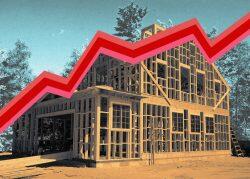Keeping up with lumber prices’ continued splinter has become a dizzying proposition for weary construction companies.
Lumber futures closed last week trading at $695 per thousand board feet, Inman reported. The cost of lumber has dropped 47 percent since early March.
The drop in costs is good news for developers and homebuilders, who have face rising materials costs on the back of labor shortages, supply chain issues and inflation.
“Outstanding uncertainty in prices is not only forcing contractors to pass on costs, but also to eliminate price caps in their contracts,” First American economist Xander Snyder said in a statement earlier this month.
While lumber costs are falling, they are still high in comparison to pre-pandemic figures. In February 2020, lumber was traded for $446 per thousand board feet, two-thirds of its futures are being traded for now.
Read more



This year’s market has seen worse. In March, lumber was trading for as much as $1,357 per thousand board feet. About a year ago, lumber hit a peak of $1,733 per thousand board feet, more than double what its futures were trading for last week.
Builders have been struggling to win a losing battle against supply chain delays since the onset of the pandemic. Privately owned housing starts rose 3.9 percent year-over-year in March, according to a monthly report from the U.S. Census Bureau. They dropped 0.2 percent from March to April, but were up 14.6 percent year over year last month.
Meanwhile, the National Association of Home Builders/Wells Fargo Housing Market Index slid for the fifth month in a row in May, CNBC reported. The report cited construction costs and rising mortgage rates as reasons for the declining sentiment.
[Inman] — Holden Walter-Warner
